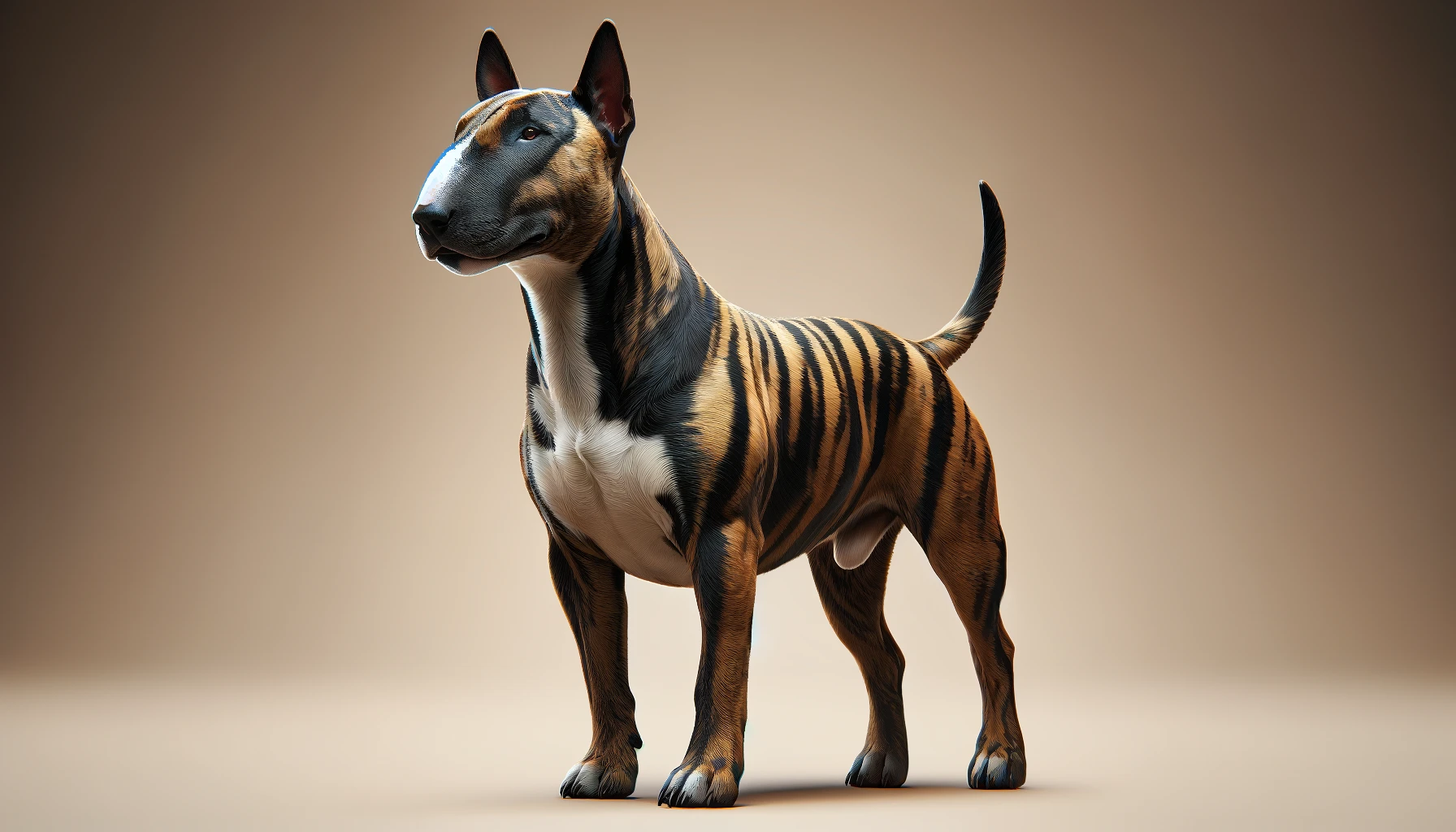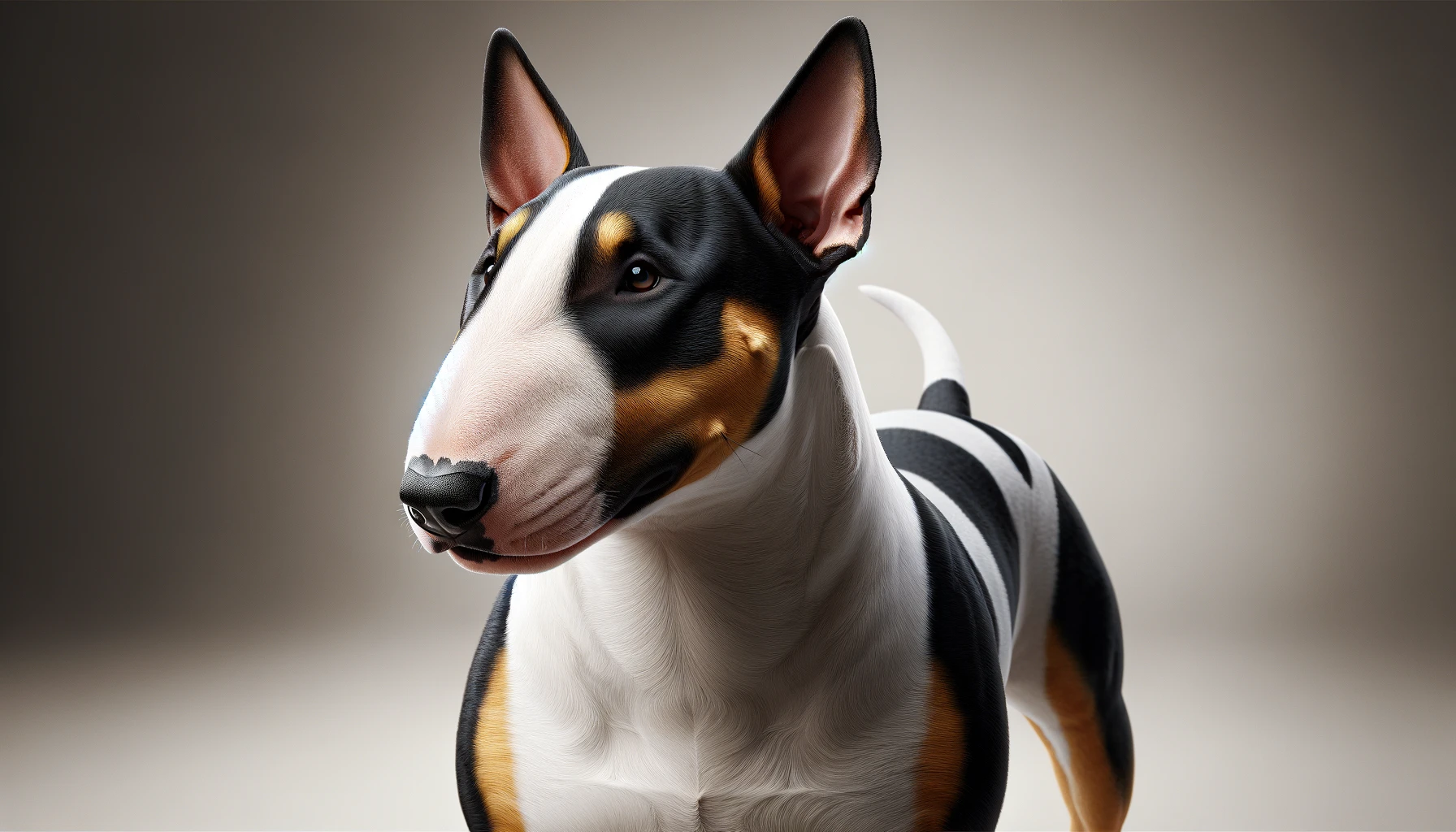Bull Terriers, known for their distinctive egg-shaped head and robust physique, are as varied in personality as they are in coat color. These spirited and affectionate dogs come in a broad spectrum of colors and patterns that are recognized and celebrated across different kennel clubs. Their coat, smooth and short, offers a canvas for a variety of stunning hues that range from pure white to vibrant brindle. Each color variation not only adds to the aesthetic appeal of Bull Terriers but also highlights unique aspects of their appearance, making each dog distinctively charming. The breed standard allows for quite a few colors and combinations, ensuring that enthusiasts and prospective owners have many options to admire. This article explores seven of the most stunning color variations of the Bull Terrier, each bringing its flair and beauty to this already eye-catching breed.
1. White

White is perhaps the most iconic color of the Bull Terrier breed. These dogs are completely white, with no other color markings except for perhaps a patch of another color on the head. White Bull Terriers showcases an elegant simplicity, making their distinctive physical features like the muscular build and oval head stand out sharply. This color variation can make skin issues more visible, which requires owners to be vigilant about skincare and sun protection. Despite their susceptibility to dirt and staining, white Bull Terriers remain popular for their striking, polished appearance that contrasts beautifully against their dark eyes and noses.
2. Black and White

Black and white Bull Terriers have a dramatic, tuxedo-like appearance that makes them particularly photogenic. This coloration features solid black patches over a predominantly white body, often with a symmetrical distribution that enhances the dog’s balanced and sturdy physique. The black-and-white variation follows the same breed standards as fully white Bull Terriers, with the only difference being the addition of black patches. This color pattern does not affect the health of the dog but does give each individual a unique set of markings that can be as unique as fingerprints.
3. Brindle

Brindle Bull Terriers are known for their striking striped pattern that combines shades of brown, black, and tan. This tiger-stripe effect gives the Bull Terrier a wild and rugged look that is highly valued among enthusiasts. The brindle pattern is not just aesthetic but is also historically appreciated for adding camouflage, an advantage in the breed’s early hunting days. Brindle can vary from light to dark, and the dense pattern can sometimes cover the entire body or be interspersed with white areas, particularly on the chest and feet.
4. Red and White

Red and white Bull Terriers present a vibrant contrast with a rich, deep red color paired with white. The red patches can range from a light copper to a dark rust, set against a crisp white background. This color combination is eye-catching and quite rare, making red and white Bull Terriers stand out in any setting. The distribution of red and white can vary greatly among individuals, with some having more extensive red coverage than others. Like other colored Bull Terriers, they require the same level of care and grooming to maintain their stunning appearance.
5. Fawn and White

Fawn and white Bull Terriers are another beautifully contrasted variation, featuring a light tan or buff color mixed with white. The fawn patches are generally softer and less intense than the reds, giving these dogs a more subdued but equally elegant look. The fawn coloring is gentle and warm, complementing the friendly nature of the Bull Terrier. This color variation is quite popular for its soft appearance that appeals to those who prefer a less bold coloration but still desire a dog with a distinct Bull Terrier physique.
6. Tri-color

Tri-color Bull Terriers are a fascinating mix of black, white, and tan. This variation includes a base of white with patches and markings of the other two colors. The placement and size of the black and tan markings can vary dramatically from one dog to another, making each tri-color Bull Terrier uniquely beautiful. This variation is especially striking because of the complex patterning, which can include a classic ‘mask’ marking on the face, making these dogs look particularly distinctive and appealing.
7. Blue

Although not as common and sometimes controversial, blue Bull Terriers display a dilute black coat that appears blue. This color is due to a specific genetic trait that dilutes the typical black pigmentation to a softer, more subtle blue shade. Blue Bull Terriers are rare and can be prone to specific health issues like skin conditions and allergies, similar to other blue-coated breeds. However, their unique coloration is highly prized by some enthusiasts who seek a truly unique Bull Terrier.
In summary, Bull Terriers offer a delightful array of coat colors that enhance their bold and charismatic presence. From the pristine beauty of the white Bull Terrier to the rare allure of the blue variant, each color provides a unique window into the breed’s diverse appeal. While choosing a Bull Terrier, prospective owners should consider not only the aesthetic qualities of these colors but also the care requirements and health implications associated with each. With their diverse palette, Bull Terriers continue to captivate and charm dog lovers around the world.
Frequently Asked Questions About Bull Terrier Colors
1. What is the most common color of Bull Terriers?
The most common color of Bull Terriers is white. This iconic color is deeply embedded in the breed’s history, originally favored to distinguish the dogs easily in the sporting arenas. White Bull Terriers are striking with their pure coats accentuating their muscular build and distinctive egg-shaped head. However, white Bull Terriers can be more prone to skin issues and allergies due to their sensitive, less pigmented skin. They may also have a higher incidence of deafness, especially if they have blue eyes. Regular check-ups and protective care against sun exposure are recommended to maintain their health and pristine appearance.
2. Are there any coat colors not recognized in Bull Terriers?
Yes, the Bull Terrier breed standard does not recognize Merle as a coat color. The merle pattern is linked to genetic health issues, including eye abnormalities and deafness, and indicates crossbreeding since it is not a natural pattern for Bull Terriers. Other non-standard colors might include blue or liver, depending on the registry. Prospective Bull Terrier owners should consult breed standards from reputable kennel clubs to understand which colors are accepted for showing and breeding.
3. Can Bull Terriers be multi-colored?
Yes, Bull Terriers can indeed be multi-colored. Commonly recognized multi-colored patterns include brindle, black and tan, and tricolor (black, white, and tan). These colors should be well-defined and not blend into each other. Multi-colored Bull Terriers are popular among pet owners for their unique and varied appearances but maintaining the clarity of these colors is important for show dogs. The distinctiveness of each color patch plays a crucial role in the aesthetic appeal of multi-colored Bull Terriers.
4. What are the grooming needs for different Bull Terrier colors?
Grooming needs for Bull Terriers are relatively consistent across different coat colors. Their short, sleek fur requires regular brushing to remove loose hairs and maintain skin health, regardless of the color. Bathing should be done sparingly to avoid drying out the skin, using a mild shampoo formulated for dogs. Additionally, lighter-colored Bull Terriers, particularly whites, may require more frequent cleaning to keep their coats bright and stain-free. Regular ear cleaning and nail trimming are also necessary to prevent health issues.
5. How does sunlight affect the coat color of Bull Terriers?
Sunlight can cause the coat color of Bull Terriers to fade, especially in darker-colored or vibrant dogs, such as reds and brindles. Prolonged exposure to the sun can lighten the coat over time and also lead to sunburn, particularly in lightly pigmented or white Bull Terriers. Owners should provide sun protection for their pets and limit exposure during peak sunlight hours to preserve the coat’s color and protect the dog’s skin.
6. Are certain colors associated with specific health issues in Bull Terriers?
Certain coat colors in Bull Terriers are associated with specific health concerns. For instance, white Bull Terriers are more prone to congenital deafness and skin cancer due to their lack of pigmentation. Blue-colored Bull Terriers might experience Color Dilution Alopecia, leading to hair thinning and sensitive skin. Owners need to be aware of these associations and seek dogs from reputable breeders who conduct appropriate health screenings.
7. What impact does coat color have on Bull Terrier behavior?
Coat color does not impact the behavior or temperament of Bull Terriers. Behavior traits in Bull Terriers are more influenced by genetics, upbringing, and training rather than coat color. It’s a common misconception that certain colors can determine a dog’s personality. All Bull Terriers, regardless of color, can display the breed’s characteristic traits of being energetic, playful, and affectionate if properly socialized and trained.
8. Why is the white Bull Terrier so significant in the breed’s history?
The white Bull Terrier, often referred to as the “White Cavalier,” holds historical significance as the color that defined the breed in its early days. This color was initially preferred to differentiate the Bull Terrier from its pit-fighting ancestors and to give it a more distinguished and noble appearance. The white coat was also valued because it made the dogs easier to spot in fighting pits. Over time, while the breed has evolved and other colors have been recognized, the white Bull Terrier remains a symbol of the breed’s elegant and spirited nature.
9. Can Bull Terriers have black and tan coloring?
Black and tan is not a traditional color seen in Bull Terriers. Typically, the breed standards do not recognize black and tan as a standard color pattern. Most Bull Terriers will exhibit either solid colors, bicolored, or tricolored patterns without the distinct tan markings common to other breeds like the Doberman or Rottweiler. If a Bull Terrier exhibits a black and tan pattern, it might be worth investigating the dog’s lineage for possible crossbreeding.
Learn More About the Bull Terrier Dog Breed: Information, Facts & Pictures
10. How do genetics determine the coat color of a Bull Terrier?
Genetics play a crucial role in determining the coat color of a Bull Terrier. The color is dictated by various genes that control the distribution and type of pigment in the coat. For instance, the gene for white is dominant, which is why it was historically common in the breed. Other colors, like brindle or black, involve a combination of recessive and dominant genes that interact to produce the final coat color. Understanding these genetic mechanisms can help breeders plan matings to produce desired colors while maintaining genetic health and diversity.
 Toledo, United States.
Toledo, United States.